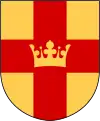Diocese of Växjö
The Diocese of Växjö (Swedish: Växjö stift) is one of the 13 dioceses or regional units of the Lutheran Church of Sweden. It was also a former Roman Catholic bishopric.
Diocese of Växjö Växjö stift | |
|---|---|
 Arms of the diocese of Växjö | |
| Location | |
| Country | Sweden |
| Deaneries | 16 kontrakt[1] |
| Coordinates | 56°52′39″N 14°48′43″E |
| Statistics | |
| Parishes | 97[1] |
| Congregations | 224[1] |
| Information | |
| Denomination | Church of Sweden |
| Established | 12th century[1] |
| Cathedral | Växjö Cathedral |
| Current leadership | |
| Bishop | Fredrik Modéus [2] |
| Metropolitan Archbishop | Antje Jackelén |
| Map | |
 | |
| Website | |
| svenskakyrkan.se/vaxjostift | |
Lutheran diocese
Diocese of Växjö is situated in southern Sweden and includes most of the county of Jönköping at its north end, the southern and central parts of the county of Kalmar, the island of Öland in the east, the county of Kronoberg in the south, and a small part of the county of Halland in the west. The diocese consists of 249 parishes, and has the highest church attendance in Sweden.[3]
The city of Växjö is the site of the episcopal see of Diocese of Växjö. In the twelfth century, the construction of Växjö Cathedral was begun and hence Växjö grew to become an important religious centre in the Diocese of Växjö. Saint Sigfrid allegedly lived and died in Växjö, and was buried in the cathedral at his death.
Former Catholic diocese
The ancient episcopal see of Växjö comprised the regions Värend and Njudung in Småland. Its patron saint was Saint Sigfrid, who in 1158 was canonized by Adrian IV[4] and his shrine was, until the Protestant Reformation, the glory of the Cathedral of St. John the Baptist and St. Sigfrid at Vexiö.
He had no immediate successors and in 1126 King Sigurd Jorsalafarer of Norway led a crusade to Småland to Christianize its inhabitants.[4] Little is known about the origin of the diocese. It may have been Danish, or it may have broken loose from the diocese of Linköping between 1164 and 1170. The second bishop was Stenar, who is mentioned in two letters dating from 1183. In 1191 he quarreled with the Bishop of Linköping concerning the frontiers of their respective dioceses. Stenar was succeeded in 1193 by John Ehrengisleson. In 1205 the biography of St. Sigfrid was written.
Bishop Gregory (about 1241), or his successor, renewed the boundary dispute with the Bishop of Linköping, which was settled by the pope in 1248 or 1249. Bishop Bo (1287–91) appealed in a dispute to the Archbishop of Lund, which was regarded as an insult to the Archbishop of Upsala. Conflict was averted by Bo's death and a declaration of obedience to the Archbishop of Upsala, issued by the chapter of Vexiö. The most famous of the later bishops was Nicolaus Ragvaldi (1426–38), present at the Council of Basle, and in 1438 translated to Upsala.
The last Roman Catholic bishop was Ingemar Petri (consecrated 1495), who, by judicious concessions, remained at Vexiö until his death in 1530. He took no part in episcopal consecrations during Gustav I Vasa's reign, when the Catholic hierarchy was replaced by the Lutheran state religion. The chapter of Vexiö consisted of dean, archdeacon, subdean and eleven prebendaries. There was also a schoolmaster. The cathedral was burnt down in 1740 and rebuilt in 1755. There were apparently no religious houses in the diocese.
References
- "Växjö stift". Nationalencyklopedin (in Swedish). Retrieved 26 August 2011. (subscription required)
- "Biskop" (in Swedish). Church of Sweden. Archived from the original on 9 November 2014. Retrieved 26 August 2011.
- The Making of Regions of Germany and Sweden Archived 30 March 2007 at the Wayback Machine
- s:Catholic Encyclopedia (1913)/Ancient See of Vexiö
General sources
 This article incorporates text from a publication now in the public domain: Herbermann, Charles, ed. (1913). "Ancient See of Vexiö". Catholic Encyclopedia. New York: Robert Appleton Company. newadvent.org
This article incorporates text from a publication now in the public domain: Herbermann, Charles, ed. (1913). "Ancient See of Vexiö". Catholic Encyclopedia. New York: Robert Appleton Company. newadvent.org

